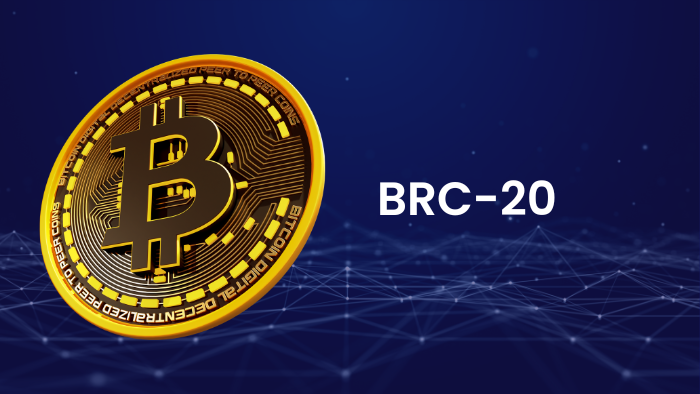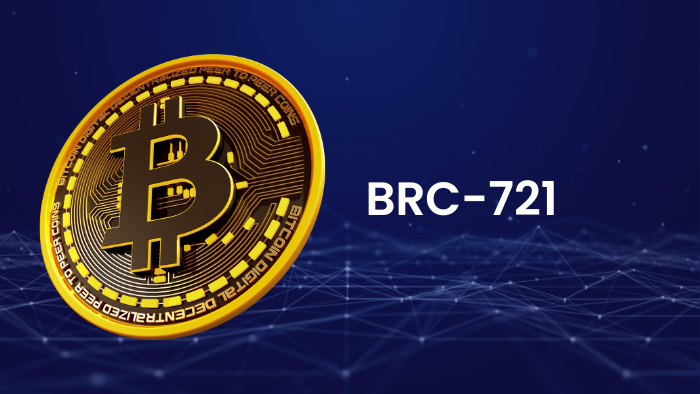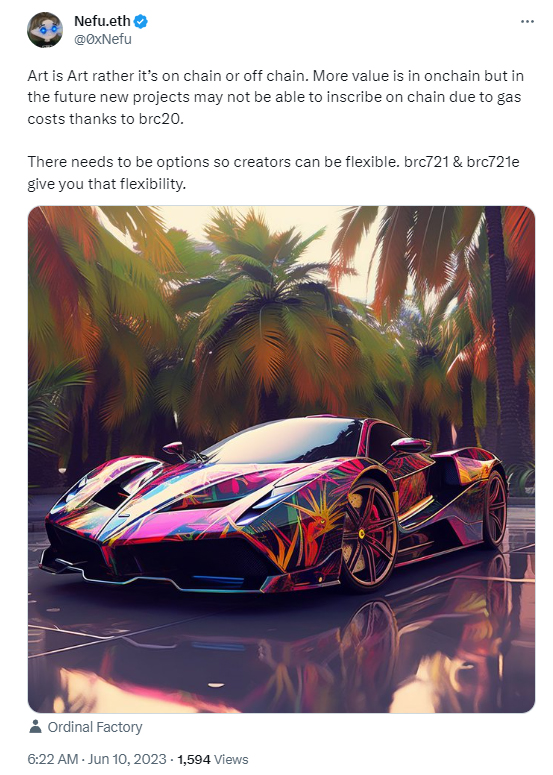Published: June 26, 2023
NFT Development Services – Understand Token Standards & BRC721E Tokens

The vast world of Blockchain technology and NFT development services has various standards for optimum working. As non-developers, most of these token standards hold little meaning to you. However, the public is occasionally introduced to a token standard that transforms the way of trading. The latest addition to these revolutionary token standards is BRC-721E, which can potentially stir the way businesses trade significantly.
What are Token Standards?
A token standard in NFT development Services and blockchain technology refers to the rules defining how a token works. It specifies the conditions and functions of how these tokens work.
Additionally, the token's properties, such as its name, symbol, total supply, and how it can be transferred, are also determined by the token standards.
Token standards are essential because they facilitate interoperability between blockchains and applications.
To understand token standards, let us first focus on the mechanism of smart contract standards. At the very fundamental level, smart contract standards are mandates that the smart contract needs to comply with to function properly under the blockchain network.
The smart contracts are application-level specifications. And people with the required knowledge about the clearly defined parameters can create custom ERC tokens.
So, token standards are a type of smart contract standards. And in blockchains that support smart contracts, token standards work as a guide to create, issue, and deploy new tokens on them.
Several token standards are already in play when it comes to blockchains. And the most common token standards in use today are generally from the Ethereum blockchain. Each of these token standards comes with its own set of strengths and weaknesses.
Some Popular Token Standards
There are many different token standards, each with its strengths and weaknesses. Some of the most renowned token standards include:
- ERC-20 Token: The most common token standard on the Ethereum blockchain.
It is a fungible token, which means that each token is identical and can be exchanged for another token of the same type.

- BRC-20 Token: Experimental Fungible Token standard
It is a standard made by Domo, a blockchain analyst, that users can utilize to transfer fungible tokens using the ordinals protocol.
 ERC-721 Token: Uniqueness Gives Them Value
ERC-721 Token: Uniqueness Gives Them Value
It is an NFT (non-fungible token) standard, meaning that every token is entirely different and cannot be exchanged at the same value with another same type of token. ERC-721 tokens are often used to represent digital assets, such as collectibles or in-game items.
 BRC-721 Token: Extending to NFT (Non-fungible Tokens)
BRC-721 Token: Extending to NFT (Non-fungible Tokens)
BRC-721 is made on the same principle as BRC-20, but it extends the capabilities of the Bitcoin network by offering the inclusion of non-fungible tokens.

The incorporation of the new token standard is allowing the Bitcoin network to manage a wider range of digital assets and value representation.
Token standards are an important part of the blockchain ecosystem. They allow for the development of interoperable applications and the creation of new types of digital assets.
What are the Benefits of Token Standards?
Each token standard is created with a purpose in mind. So, when it comes to determining the strengths of every token, it is a more comprehensive list. However, generally, here are the benefits of token standards.
Interoperability
Interoperability is the ability of blockchain networks to exchange data. And token standards can facilitate interoperability between different blockchains and applications.
The tokens can be transferred between different blockchains and used in different applications.
Standardization
Token standards formalize the way that tokens work. The function makes it easier for developers to create applications that use tokens.
Security
Token standards can help improve token security as token standards can determine how tokens are created, transferred, and stored.
What are the Various Drawbacks of Token Standards?
Of course, every element comes with its own set of disadvantages, and token standards do not deviate from this norm. Here are some common problems with token standards:
Limited functionality:
Token standards can limit the overall functionality of tokens as token standards are made to be generic and cannot be tailored to specific use cases.
Centralization:
Token standards go against the very core of blockchain technology that wants to offer decentralized autonomous organizations, as they can lead to centralization. As token standards are often developed and maintained by a small group of people, they automatically get more control over the system.
Lack of innovation:
Token standards can suppress innovation. They limit the scope of innovative app development.
Overall, token standards are an essential element of the blockchain ecosystem. They provide several benefits, such as interoperability, standardization, and security. However, there are also some drawbacks to using token standards, such as limited functionality, centralization, and lack of innovation.
Understanding BRC-721 Tokens
We have lightly touched upon the implications of BRC-721 tokens before. So, to refresh, these token standards are making the Bitcoin network capable of managing NFTs. The token standard allows for the creation, ownership, and transfer of these unique pieces on the Bitcoin blockchain.
As each token created under the BRC-721 token comes with a unique identifier, these tokens are distinct and are not interchangeable.
What does this imply?
Previously, Ethereum had an edge over Bitcoin in terms of managing NFTs. So, Bitcoin needed to provide additional support to remove the almost monopoly that Ethereum had on NFT development. The BRC-721 tokens offer exactly that.
It also means that businesses can now create NFTs on Bitcoin, and you need experts in the field.
But that is not all. Currently, if you have NFTs on the Ethereum blockchain, you can also transfer them to the Bitcoin blockchain using the next token we are discussing.
What is a BRC721E token?
 There was a time when if you owned an NFT on one blockchain, you could not transfer it to another blockchain of choice. Now, we obviously want to avoid duplication, so it is necessary that when and if a user chooses to move the NFT between blockchains, it does not lead to two commodities.
There was a time when if you owned an NFT on one blockchain, you could not transfer it to another blockchain of choice. Now, we obviously want to avoid duplication, so it is necessary that when and if a user chooses to move the NFT between blockchains, it does not lead to two commodities.
Blockchain engineers have tackled that exact problem by creating the BRC 721E token standard. This token will enable NFT marketplace development services providers to offer this unique service to their clients and the end users of the platform.
So, what can the BRC 721E token do?
Well, simply put, that token standard allows the users to convert their Ethereum-based NFTs into Non-fungible tokens on the Bitcoin network.
It means that now you can take your prized possession from the higher service charges bank to a lower service charges bank virtually. Although your reason for transfer may vary, the token does offer the service.

Now, you may be asking if that will lead to duplicity.
The engineers thought of that too. So, how this works is that the NFT holders will burn the tokens and inscribe them on the Bitcoin network. Once the inscription is complete, the tokens will appear on your Market collection page along with their complete metadata.
They can represent anything from digital art to in-game items. BRC721E tokens are similar to ERC-721 tokens, the most popular type of NFT on the Ethereum blockchain.
However, BRC721E tokens offer several advantages over ERC-721 tokens, including:
- Lower fees
The Bitcoin blockchain is much cheaper to use than the Ethereum blockchain, which means that BRC721E tokens have lower transaction fees.
- Faster transactions
The Bitcoin blockchain is also much faster than the Ethereum blockchain, which means that BRC721E tokens can be transferred more quickly.
- More secure
The Bitcoin blockchain is considered to be more secure than the Ethereum blockchain, which makes BRC721E tokens more secure.
How are BRC721E tokens used?
The NFT Development services can use the BRC 721E tokens in various places, including
Digital art:
BRC721E tokens can denote digital art, such as paintings, photographs, and music.
In-game items:
BRC721E tokens can also represent in-game items like weapons, armor, and pets.
Real-world assets:
BRC721E tokens can convey real-world assets, such as real estate, cars, and jewelry.
Identity:
BRC721E tokens can also represent a person's identity, such as their name, date of birth, and address.
It does not mean that BRC721E tokens do not have any disadvantages. To begin, NFT marketplace on Solana blockchain will not come under the token. It is only limited to converting Ethereum NFTs into Blockchain entities.
But given the fact that it is a hit among the users, more such tokens are likely to arrive in some time.
What are the various types of manifest in BRC 721E?
The developers have introduced three types of manifests:
Collection Manifest
ERC721 smart contract only stores immutable collection parameters but does not do anything else. It is the definitive source of information for your collection and contains essential data such as max supply, max per address, and max block height. Consider this manifest as an immutable contract on Ethereum.
Inscription Manifest
NFT token that points to the contract. The inscription manifest functions similarly to an NFT token. It refers back to the collection manifest. It includes the initial owner's address and price in sats. The initial owner's address comes in handy when you have an allowlist, and you want to restrict minting to specific addresses.
Reveal Manifest
It is a reliable source for your metadata. BRC721 relies on the ERC721 metadata standard. The metadata is stored off-chain and linked to the collection.
Similar to ERC721 baseURI and token URI properties.
Just like in ERC721, you have the option to update the metadata URL to incorporate a reveal mechanic.
This is achieved by deploying another reveal manifest with a higher priority. This priority is controlled by the weight field in the manifest.
Verification of BRC 721E Tokens – Guaranteeing the linked nature of all these manifests and validating the data
To validate the data, and ensure the linked nature of the manifests, public and private(secret) keys prove vital.
All the manifests and their content are linked and signed with your private key. It is essential to save them in secure storage. You will need these keys to, for example, create a new reveal manifest or issue new inscription manifests (NFTs). A good practice is to have a separate pair of keys for every collection you inscribe and manage.
But what happens if someone attempts to cheat?
For instance, what if someone modifies the inscription price or initial owner's address or simply refuses to pay for the NFT?
If the inscription content is altered, the signature becomes invalid, thus breaching the specification. If the payment is not made, it constitutes a violation of the specification rules.
Consequently, the inscription will not be verified and included in the collection. The person who made these changes will be left with a worthless text inscription. The same outcome awaits anyone trying to mint beyond the allowed limit or if the max supply has been reached.
How to Prepare Wallet and Keys for BRC – 721E Tokens:
- Download and recharge the OrdinalSafe wallet with at least 40000 SATS (0.0004BTC). Currently, it is the only wallet that supports BRC-721 but more integrations are in the pipeline.
- Create Public and Private key using the Ordianl Safe wallet.
- Press Edit, and then copy and save your keys to secure storage. You will need them later to issue new tokens.
- Press on Connect Wallet to be able to inscribe manifests.
Now you are all set and ready to create your first collection!
The future of BRC721E tokens
BRC721E tokens are a new type of token standard that has the potential to revolutionize the way that we interact with digital assets. They are cheaper, faster, and more secure than ERC-721 tokens, and they can be used to represent a wider range of assets.
Final Thoughts - Avail NFT Development Services
The scope of blockchain technology and NFT development services is only rising. Therefore, businesses that want to remain innovative and serve their clients wherever they choose must hire an NFT marketplace development company to assist them with the transition.
Blockchain technology is only going to see a rise in users as NFTs become more popular, and businesses that are ready to serve the users on the blockchain of their choice will be at an advantage.
Get in touch with MoogleLabs to discuss how you can leverage the technology for your business. Our knowledge of the various programming languages for blockchain solutions and zeal to keep learning and innovating makes us the ideal partner for all tech-inclined organizations.
FAQ
Gurpreet Singh
Gurpreet Singh has 10+ years of experience as a Blockchain Technology expert and is the current Vertical head of the blockchain department at MoogleLabs, contributing to the blockchain community as both a developer and a writer. His work shows his keen interest in the banking system and the potential of blockchain in the finance world and other industries.
Recent Blog Posts
No recent blogs available.
